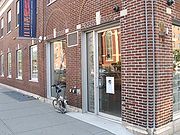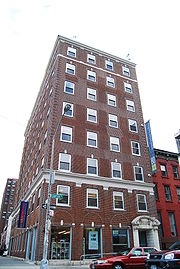
Museum of Contemporary African Diasporan Arts
Encyclopedia

New York City
New York is the most populous city in the United States and the center of the New York Metropolitan Area, one of the most populous metropolitan areas in the world. New York exerts a significant impact upon global commerce, finance, media, art, fashion, research, technology, education, and...
borough of Brooklyn
Brooklyn
Brooklyn is the most populous of New York City's five boroughs, with nearly 2.6 million residents, and the second-largest in area. Since 1896, Brooklyn has had the same boundaries as Kings County, which is now the most populous county in New York State and the second-most densely populated...
. It is the first museum of its kind to be opened in New York. Its mission is to foster a greater awareness and appreciation of the arts and cultures of the African Diaspora
Diaspora
A diaspora is "the movement, migration, or scattering of people away from an established or ancestral homeland" or "people dispersed by whatever cause to more than one location", or "people settled far from their ancestral homelands".The word has come to refer to historical mass-dispersions of...
as it relates to contemporary urban issues. The experiences and cultural contributions of people of African descent have been marginalized throughout history and MoCADA’s mission is to undertake the responsibility of rewriting that history in order to give a more accurate portrayal of the contributions of people of African descent to the artistic and global landscape.

History
MoCADA was founded in 1999 in a building owned by the historical Bridge Street AWME Church in the heart of the Bedford-Stuyvesant community in Brooklyn, New York. Laurie A. Cumbo founded MoCADA in response to Brooklyn’s overwhelming need for a museum reflective of the arts and cultures of the African Diaspora. To achieve these ends, the MoCADA Planning Headquarters was created to begin the initial planning of the building and construction. The objective was to fulfill the daily tasks and responsibilities required to launch a project of incredible magnitude. These tasks included hosting community planning meetings, fundraising events, grant writing, garnering community support and communication. Moreover, the temporary space allowed MoCADA the opportunity to mount modes art exhibitions to artists with limited options.In 2006 MoCADA moved to its current home, an expanded space at 80 Hanson Place, at South Portland Avenue, in Fort Greene, a historically black middle-class
Black middle class
The black middle class, within the United States, refers to African Americans who occupy a middle class status within the American class structure. It is predominately a development that arose after the 1960s, during which the African American Civil Rights Movement led to reform movements aimed at...
neighborhood in Brooklyn which is home to the Brooklyn Academy of Music
Brooklyn Academy of Music
Brooklyn Academy of Music is a major performing arts venue in Brooklyn, a borough of New York City, United States, known as a center for progressive and avant garde performance....
(BAM) arts district. MoCADA has grown to accommodating many exhibitions throughout the year that highlight various identities of the African Diaspora. The central location of Fort Greene, allows for a cross section of the Brooklyn community to gather at MoCADA and partake in the many events produced for each exhibition. With a large bookstore, MoCADA holds the space for such events as book readings, student tours and musical events.
Exhibitions
Saying No: Reconciling Spirituality and Resistance in Indigenous Australian Art is an exhibition curated by Australian artist Bindi Cole. Based on Cole's previous exhibition in Australia, Saying No combines the religious ceremonial practices highlighted by Indigenous artist with the protest for Indigenous rights and visibility in the public imagaination. The curatorial statement is as follows: "The word 'no' does not exist in the Australian Aboriginal languages. Where it does exist, this powerful word is reserved for the elders and is used with great care and ceremony. As these languages reach the brink of extinction, indigenous Australian artists are using contemporary art to assert their identity and culture and say no to racism, land theft and colonialism in an urban world. Saying No features sculpture, installation, painting, photography, video, audio and mixed media works." Some of the exhibiting artists include Tony Albert, Vicki Couzens, Fiona FoleyFiona Foley
Fiona Foley is a contemporary Indigenous Australian artist from Badtjala, Fraser Island, Queensland.She studied at the Sydney College of the Arts. She has travelled as an artist internationally and to remote communities in Northern Territory...
, Daniel Boyd and Maree Clark.
_________________________________________________________________________________________________________________________________________
Re-imagining Haiti
Haiti
Haiti , officially the Republic of Haiti , is a Caribbean country. It occupies the western, smaller portion of the island of Hispaniola, in the Greater Antillean archipelago, which it shares with the Dominican Republic. Ayiti was the indigenous Taíno or Amerindian name for the island...
was a two-part exhibition curated through a partnership between MoCADA and the Caribbean Cultural Center African Diaspora Institute (CCCADI). MoCADA and CCCADI celebrate capstone anniversary years and pay tribute to the tenacity and resilience of our brothers and sisters in Haiti. Re-Imagining Haiti is a collaborative exhibition project that reflects a desire to preserve sacred traditions as well as contribute to a collective vision of what Haiti can become in the future.
CCCADI presented the exhibit Standing with Papa Legba: Vodou at the Crossroads. This is an exhibition that explores the state of contemporary practices of Vodou and the aesthetic traditions associated with this ancient spirituality.
MoCADA presented Le Projet Nouveau, a multi-media platform that reflects the voices of many artists who propose ecological, cosmological, architectural and sociological methods to be used in Haiti's reconstruction. Coinciding with the 1st anniversary of the devastating earthquake that ravaged the country, Re-Imagining Haiti serves to facilitate the production of ideas and actions in modern day Haiti. Le Projet Nouveau brings together 18 artists whose work presents ideas about the re-construction of Haiti. The exhibiting artists draw upon political, cultural, architectural and socio-economic themes to propose what can be offered towards the re-shaping of the first black republic. The exhibition highlights the aesthetic response of artists to the turbulence that has plagued the nation since it gained independence from France in 1804. The artists in the exhibition used their practices to visualize Haiti's future by re-imagining the country through its people, its culture, the African Diaspora, and its artistic legacy. The artists featured in this exhibit are as follows: Trevor Brown
Trevor Brown
Trevor Brown is an English artist from London presently living in Japan whose work explores paraphilias, such as pedophilia, BDSM, and other fetish themes. Innocence, violence and Japanese popular culture all collide in Brown's art....
, Nelson Caban, Rebekah A. Frimpong, Edouard Steinhauer, Michele Stephenson, Wahala Temi, Adrienne E. Wheeler, Nathan Williams, Tracee Worley.
List of Past Exhibitions
- Ain't I A Woman
- Gentrification of Brooklyn
- Johannesburg to New York
- Perspectives: Women, Art and Islam
- I Am A Man
- Dread Scott: Welcome to America
- Black Madonna
- They Won't Budge: Africans in Europe
- The Middle Passage: White Ships, Black Cargo
- Arturo Lindsay: Love
- The French Evolution: Race, Politics and the 2005 Riots

